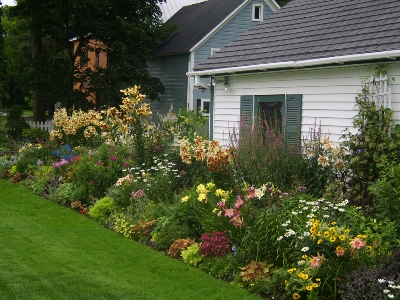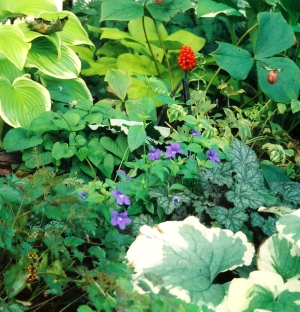Assessing Sunlight
Allow me to shed light on one of the most common reasons for lackluster gardens.
Many people are in la-la land when it comes to understanding their garden’s light conditions. The lighting is determined more by what plants grabbed their attention and pocketbooks at the garden centers versus the actual hours of sunlight the garden receives. Backwards thinking, or, as Dr. Spock would say on Star Trek, illogical. If we want healthy, bloom-splendiferous gardens, we need to be good matchmakers. Pairing plants to their required light condition is a must.
 It is a common myth that full sun beds are more beautiful and easier to grow than their shadier cousins on the other side of the railroad ties. How did this fairy tale get started? I think it is because most people are more familiar with sun-loving plants and therefore conclude shade gardening offers few choices; translating to boring. But just because you haven’t been introduced to the magical and exquisite world of shade plants, doesn’t mean they don’t exist. In reality, there are many super shade perennials that are unparalleled in their beauty. And I am not referring to just green hosta and pink bleeding hearts. I’m talking Foamflowers, Bishop’s Hat, Siberian Bugloss, Bugbane, Toad Lily, Masterwort and many other exotic beauties.
It is a common myth that full sun beds are more beautiful and easier to grow than their shadier cousins on the other side of the railroad ties. How did this fairy tale get started? I think it is because most people are more familiar with sun-loving plants and therefore conclude shade gardening offers few choices; translating to boring. But just because you haven’t been introduced to the magical and exquisite world of shade plants, doesn’t mean they don’t exist. In reality, there are many super shade perennials that are unparalleled in their beauty. And I am not referring to just green hosta and pink bleeding hearts. I’m talking Foamflowers, Bishop’s Hat, Siberian Bugloss, Bugbane, Toad Lily, Masterwort and many other exotic beauties.
 I much prefer shade gardening. Shade beds have an allure of their own. They are much more intriguing and provocative than sun gardens plus they need far less maintenance. There are four reasons why shade gardens allow more time in the lounge chair. Typically they demand less water, have fewer weeds and require less deadheading, a task I detest. Many shade perennials will not rebloom with deadheading. Once the flowers are spent, you can whack them off or leave them on for dried flower interest. The fourth factor contributing to less work in shade beds has to do with sunlight. Finally, because there is less light, plants tend to grow more slowly which means less frequent dividing. Yes, dividing is good in that you get more plants and it stimulates new roots and better flowering, but it also takes our time and energy – not good.
I much prefer shade gardening. Shade beds have an allure of their own. They are much more intriguing and provocative than sun gardens plus they need far less maintenance. There are four reasons why shade gardens allow more time in the lounge chair. Typically they demand less water, have fewer weeds and require less deadheading, a task I detest. Many shade perennials will not rebloom with deadheading. Once the flowers are spent, you can whack them off or leave them on for dried flower interest. The fourth factor contributing to less work in shade beds has to do with sunlight. Finally, because there is less light, plants tend to grow more slowly which means less frequent dividing. Yes, dividing is good in that you get more plants and it stimulates new roots and better flowering, but it also takes our time and energy – not good.
